Carlton Gardens (Carlton)

Designed for the Melbourne International Exhibition of 1880, the Royal Exhibition Building and surrounding Carlton Gardens are World Heritage listed.
The gardens feature flowerbeds, ornamental lakes, elaborate fountains and mature European trees that reflect the changing seasons. In particular, look out for the Victorian-era Hochgurtel Fountain and circular French Fountain, plantings in honour of the Dalai Lama and the two ornamental lakes created for the 1880 exhibition.
The gardens take in the Royal Exhibition Building, the Melbourne Museum, the Carlton Gardens Tennis Courts, a children's playground and a collection of Moreton Bay fig trees where local Aboriginal people have traditionally met and socialised.
Sculptures and Monuments:
Hochgurtel Fountain
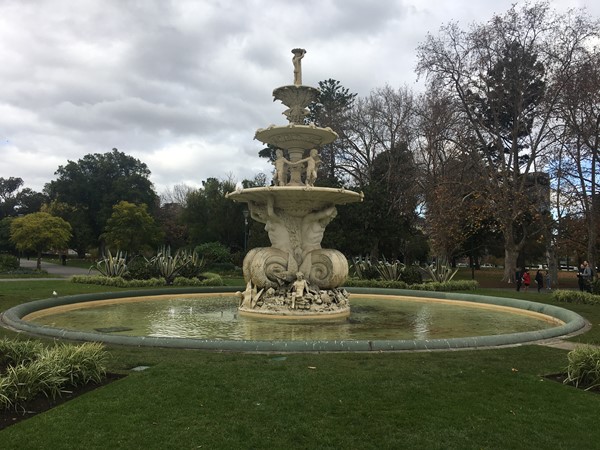
By Josef Hochgurtel (1880)
The colossal fountain stands some ten metres high and was constructed for the first of Melbourne's two grand international world fairs. The fountain's visual elements were designed to display the young colony's confidence and advancement, simultaneously signalling the purpose of world fairs to display the produce and industry of nations.
At the central level of the fountain, four youths (representing a young and vibrant colony) dance below symbols of the arts, science, commerce and industry; for example, musical instruments, a telescope, sailing ship, steam engine and globe of the world. Above this are images of Victoria's indigenous flora and fauna, and a boy with a clamshell. Holding all of this aloft are four merpeople rising up from the waters of the lower pool.
Built during Victoria's boom years, the fountain's spouting water, it was thought, would demonstrate the power and success of the recently established Yan Yean project, which brought potable water to the city. On opening day, however, the pressure was too poor to affect much more than a spurt from atop of the grand edifice.
Location: South side of the Royal Exhibition Building, outside the Great Hall.
Stone Obelisk Quarried from Stawell
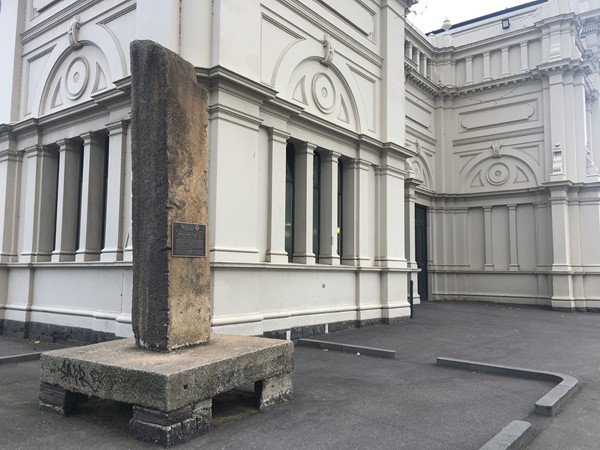
(1979)
The Obelisk of Victorian Sandstone was erected by a Member of Parliament John Woods, as a protest against the use of New South Wales sandstone to extend Parliament House. He stated that the stone from his electorate was just as durable.
The plaque on the obelisk reads "This pillar of stone quarried from Stawell was placed here on the insistence of the Hon. John Woods, M.P. (born Liverpool England November 5th 1822, Died Brighton, Victoria April 2nd 1892; engineer, politician and inventor, commissioner international exhibition 1880 and exhibition trustees 1881 - 1892) to express his indignation of the choice of New South Wales stone for the Parliament House and to show the enduring qualities of local stone."
Location: South east corner of the Royal Exhibition Building.
Dr Louis Smith Bust
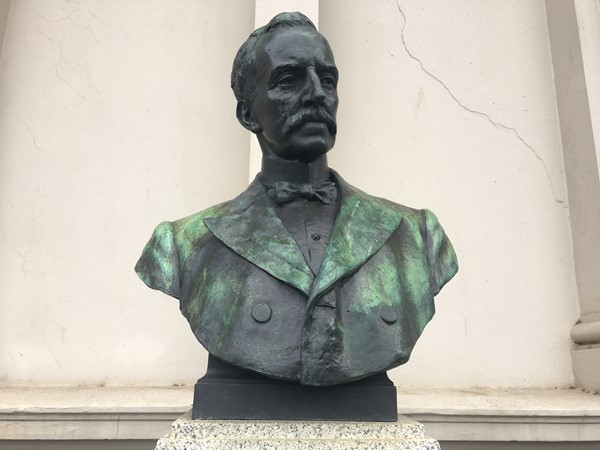
By Sir Edgar Bertram MacKennal (1914)
A bronze bust with granite pedestal. Born in London in 1830, Dr Louis Smith immigrated to Melbourne in 1852. Besides medicine, Smith had a career as a politician, during which he was accused and acquitted of corruption several times. An important figure during the development of the Exhibition Building, Smith was chair of the trustees from 1884 to 1909 and a trustee from 1881 until his death in 1910. The bust of Smith was funded by public subscription.
Location: Near the east entrance of the Royal Exhibition Building.
French Fountain
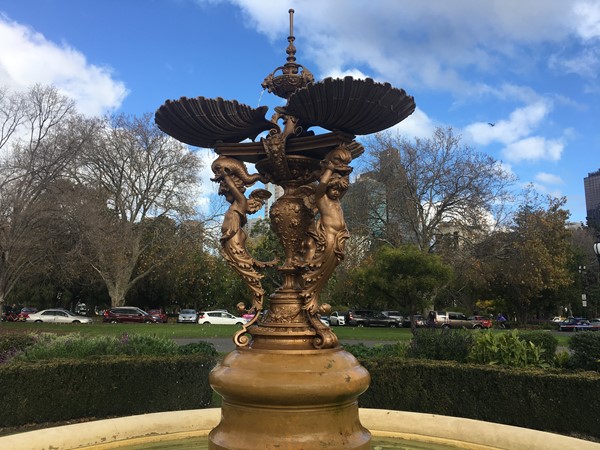
By Unknown Maker (c1880)
The bronze fountain features three youths, each supporting a dolphin, above which rests a cupped scallop shell.
During Melbourne's International Exhibition of 1880, the French Fountain formed the centrepiece of the exhibition's fernery. It was later transferred to a flowerbed at the eastern entrance to the Royal Exhibition Building. The fountain forms the centrepiece of a round garden bed and its waters flow into the large, concrete pool in which it sits.
Location: Nicholson Street entrance to the Royal Exhibition building.
Colonial Square
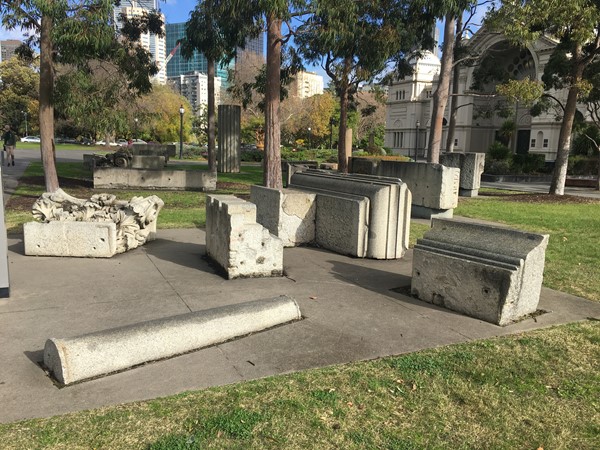
The carved stone blocks assembled at Colonial Square in the Gardens are a reminder of one of the richest periods in Melbourne's architectural history. The blocks of granite are from the former Colonial Mutual Life Building, a lavish 'Americanised Renaissance' building constructed in 1896 by noted Melbourne builder David Mitchell, who also built the Royal Exhibition Building.
Grey granite quarried at Harcourt near Castlemaine was used for the building's shell. Pink granite from Cape Woolamai on Phillip Island formed a portico at the majestic main entrance. The seven-storey CML Building stood proudly on the corner of Collins and Elizabeth Streets from 1896 until it was demolished in 1960.
There is a photo on the site of the facade of the Colonial Mutual Life Building. Circles on the photo indicate former positions of some of the stones.
Location: Near the Nicholson Street entrance to the Royal Exhibition building.
Westgarth Fountain
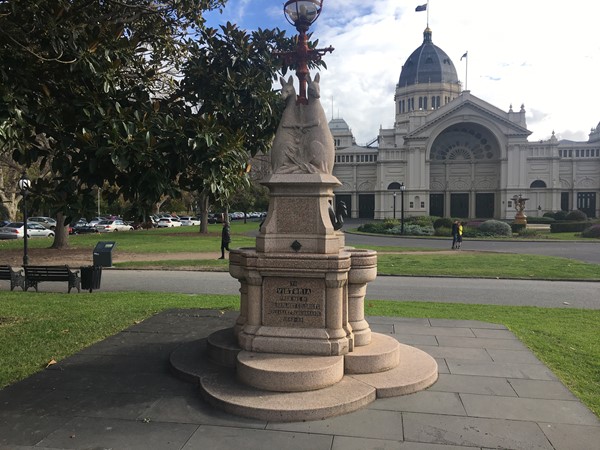
The Westgarth Fountain featuring kangaroos smoothly carved in Aberdeen granite was a gift to the people of Melbourne by pioneer settler William Westgarth in 1888. It was designed to cater for the whole family with water spouts for adults at the top, children in the middle, and a trough for the dog at the bottom.
Location: East of the Royal Exhibition building (Nicholson Street).
Access for Dogs:
Dogs are permitted on-lead.
Location
1-111 Carlton Street, Carlton 3053 Map











